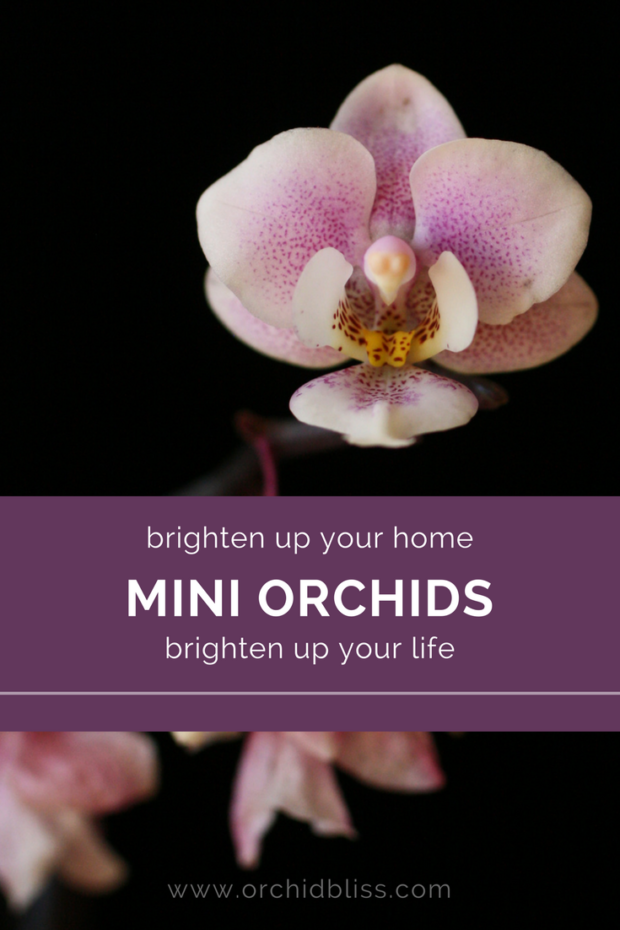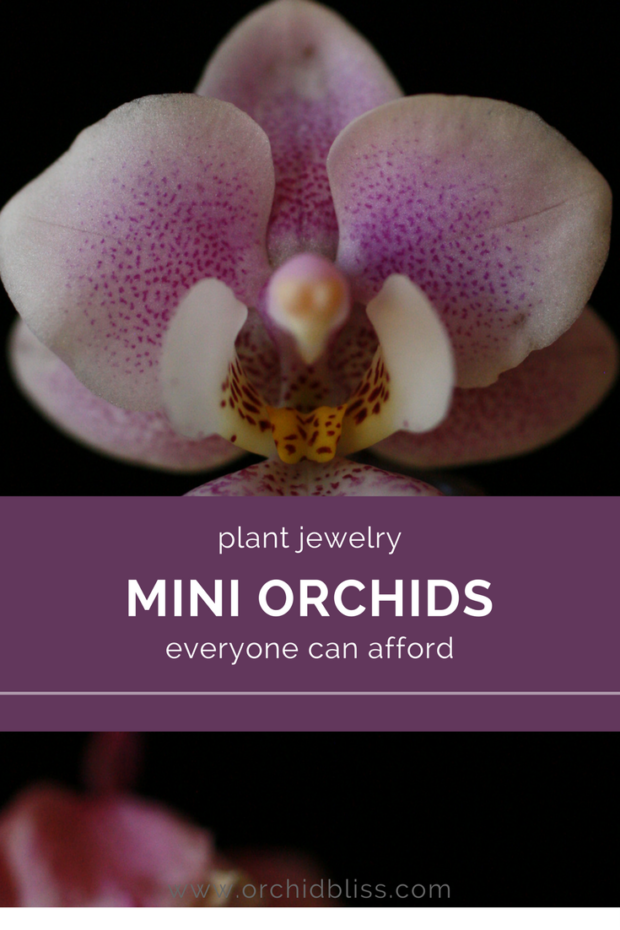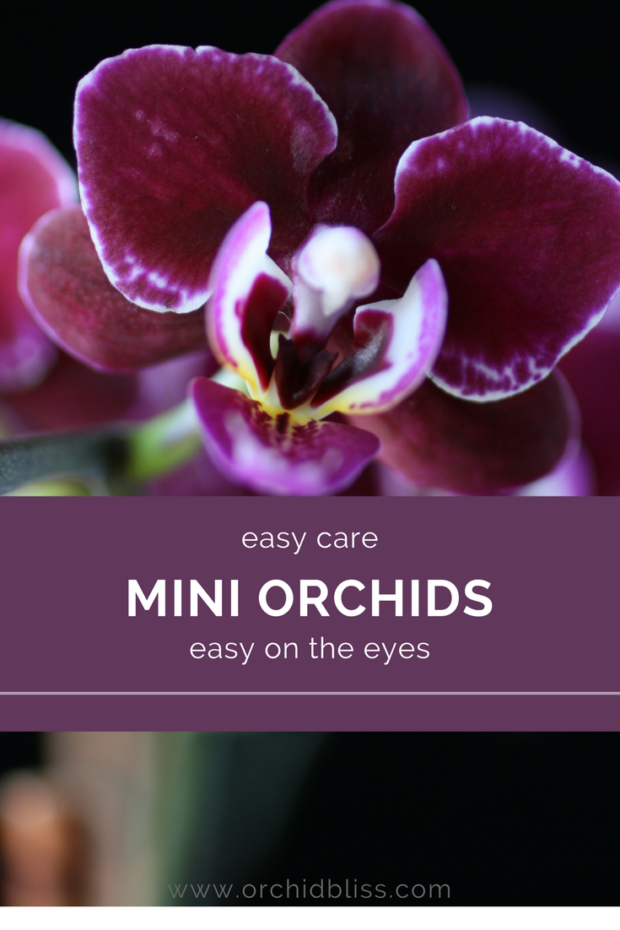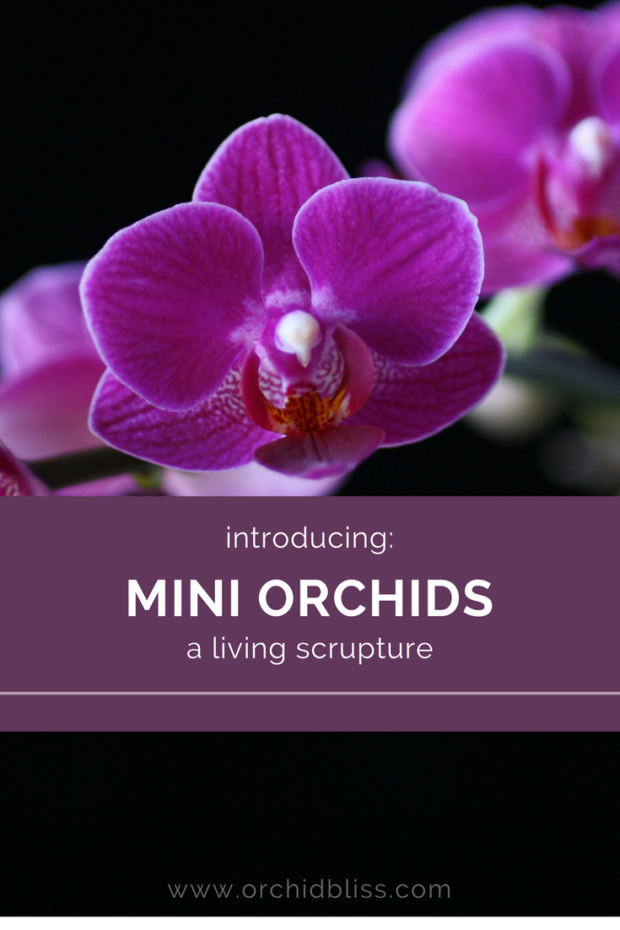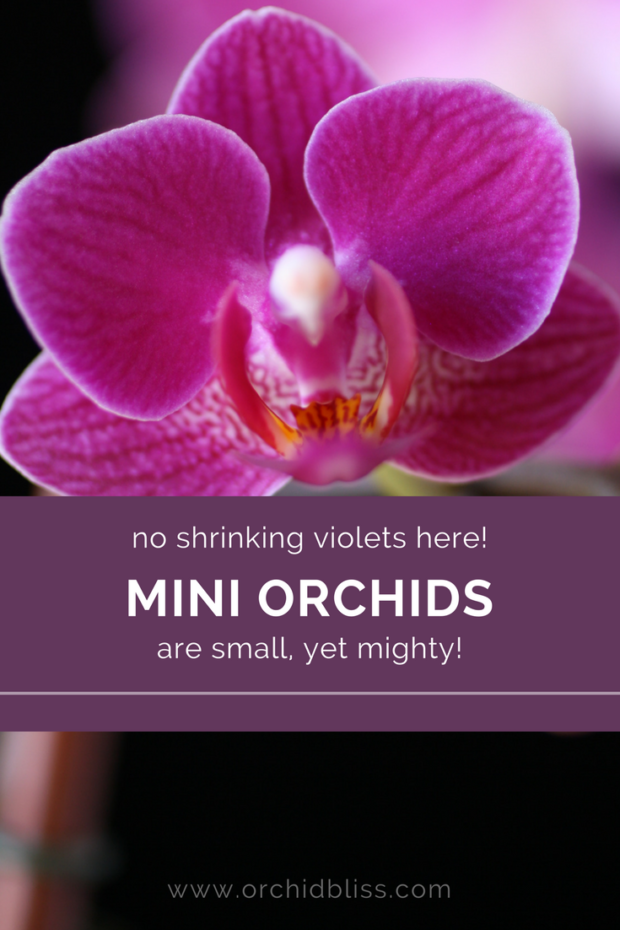
Mini orchids are growing in popularity as their diminutive size makes them ideal for the space-conscience home grower. Since these orchids are smaller than your average orchid, you might be wondering about their care, specifically how mini-orchid care differs from standard-size orchids.
Special Care Considerations for Mini Orchids
Watering | The small pot size of mini orchids means that the potting media should be checked daily for dryness. |
Fertilizing | Use care not to burn the small roots. Every other week use a balanced fertilizer, cutting the dosage by 50%. Never soak a mini orchid water with added fertilizer longer than 60 seconds. |
Potting | Choose the pot and the partical size of the potting media according to the size of the orchid's roots. |
Blooming | Avoid inconsistent watering. Take care that the orchid receives sufficient light and proper temperatures. |
There is quite a bit of difference between mini orchid varieties. To help you decide which mini orchid varieties will work best for you, I’ve gathered examples of 7 mini orchids, as well as relevant care specifications for each one. These will give you an idea of which mini orchids you’re ready to try.

Some of the links on this page may be affiliate links. Click here to learn more.
1. Mini Phalaenopsis Orchids
I have fallen in love with mini Phalaenopsis orchids. They are more compact than the traditional variety and are loaded with blooms and come in a variety of colors. Like other Phalaenopsis orchids, the blooms will last for months.
Watering
The key to watering orchids potted in sphagnum moss is to avoid overwatering them. It is helpful to remove the plastic liner pot that the orchid is growing in. The orchid’s roots hold the sphagnum moss in place. Removing the plastic liner gives the roots air circulation and keeps the moss from retaining too much water.
Blooming
Phalaenopsis orchids are susceptible to bud loss. To prevent your orchid from losing its buds, place it in a location where it will receive bright, but indirect light – away from drafts such as air vents and exterior doors.
After the flowers die, cut the stalk one inch up from the node closest to the crown. After a few months, a new stalk will emerge, followed by tiny buds. Trimming the stalk will keep the plant healthier and produce more flowers in the future.
To help you further, start by downloading my free cheat sheet to see where to cut the orchid flower spike after the blooms have faded to trigger re-blooming. Click here for the cheat sheet. It’ll be super helpful.
Buying Tip: If purchasing your mini at your local grocery store, make sure that the potting media is not completely dried out. Because their pots are so tiny, they dry out more quickly than larger orchids. One trick, if you can stand to wait, is to talk to the florist at your local grocery store and ask when the next shipment is due. This way you’ll have the best selection, and the plants will be at their prime. You pay the same for the plants that have sitting on the shelf as you do for the ones just shipped in.
In case you’re wondering where my favorite place to buy mini Phals is, check out Floralistic. These orchids are the lowest-priced, yet come in a variety of colors. Floralistic sells phalaenopsis in both 2-inch pots and in 3-inch pots.
2. Mini Cattleya Orchids
Standard-size Cattleya orchids can be LARGE. Mini Cattleyas are a boon to those of us with limited space and are rewarding to grow. Mini cattleya will stay under 6″/15cm and can be grown in a 3-4″/7-10cm pot.
Watering
Just like their standard-size counterparts, Cattleyas like to dry out between watering. Just keep an eye on the potting media – you don’t want the orchids to dry out.
Potting
By mounting a mini cattleya you will be able to delay potting for many years, but you won’t have to worry about mini catts taking over your grow space. Be aware that mounted orchids dry out faster than potted orchids.
Blooming
In addition to lots of bright light, and moderate temperatures, to get your mini cattleya to bloom, choose an award-winning mini cattleya. Cattleyas have been highly hybridized – some with better results than others.
3. Mini Cymbidium Orchids
Unlike regular cymbidiums that require cool temperatures to re-bloom, Modern and Asian miniature cymbidiums are warm growers and are perfect for a home environment.
Watering
Although cymbidiums are considered semi-terrestrial, the pot should have excellent drainage to prevent root rot.
Potting
Regular-sized cymbidiums are a real beast to re-pot, but the minis are far more manageable.
Blooming
Besides their smaller size, miniature cymbidiums do not require cool temperatures that are often difficult for the home grower to achieve in order for the cymbidium to initiate blooming.
4. Psygmorchis Pusilla, Miniature Oncidium Orchid
There are some very tiny oncidium orchids that are readily available. One such variety is the Psygmorchis Pusilla.
Watering
Pusilla orchids that come in a sealed glass jar do not need to be watered. If the orchid is mounted, take care that the orchid does not dry out.
Potting
These orchids are usually mounted on a small slab of tree fern and wrapped in sphagnum moss or are in a sealed glass jar.
Blooming
These orchids can have more than one flower spike. The flower is disproportionately large compared to the 2-inch-sized plant.
5. Oncidium Twinkle
This teacup-sized oncidium orchid packs a delightful vanilla-like fragrance.
Watering
As with other miniature orchids, the small pot size means the orchid may require watering several times a week.
Potting
The maximum pot size for Twinkle is no larger than 3-in./7.5cm.
Blooming
This little orchid can produce an abundance of flowers that will bloom throughout the fall until after Christmas.
6. Dendrobium Enobi
This award-winning dendrobium orchid is a must-have for every orchid collection.
Potting
Many dendrobiums are top-heavy, but you won’t have any trouble with this compact orchid falling over.
Blooming
The Den. Enobi will produce multiple flower spikes throughout the year. Each spike laden with magenta-colored flowers.
7. Mini Paphiopedilum – Mini Slippers
I am a sucker for compact paphiopedilums. Every time I go to the Salt Lake City Orchid Show, I buy another one.
Watering
Slipper orchids are unique because unlike most sympodial orchids they do not have pseudobulbs that provide water storage. These orchids like their potting mix slightly damper than most other orchids.
Potting
These orchids are not fussy about when you re-pot. Just be sure that you do it every year.
Blooming
Slipper orchids grow large, pendulous flowers. On the mini varieties, the flower stem is much shorter, making it less fragile.
Mini Orchids Make Great Gifts
Mini orchids make a perfect gift either for yourself or for someone else. For instance, don’t underestimate a mini phalaenopsis. They may be small, but they are tough. Their flowers will last for several months. Often mini Phals will have more than one flower stalk. And, they are available for a fraction of their full-size counterparts.
How to Create Your Own Mini Orchid Arrangement
Grouped together, mini orchids can look quite stunning. Just by placing three orchids together in one shallow tray, you can easily create a single arrangement.
Materials
- 3 mini orchids can be purchased at your local grocery store or online. You can go for either a variety of colors or flowers that are all the same color. (A less expensive online option is to buy bare root orchids, though they will not be in bloom.)
- A shallow container with a wide, flat base. This could be a basket, a piece of pottery, or a tray. Look for one at a craft store or hopefully, you may already have one stashed around your house.
- Prepackaged mixed moss is available at craft stores and online.
- Leaving the orchids in the little pots that they came in, set the mini orchids in the container.
- Fill in the gaps between the orchid pots with the moss, and, voilà you’re done.
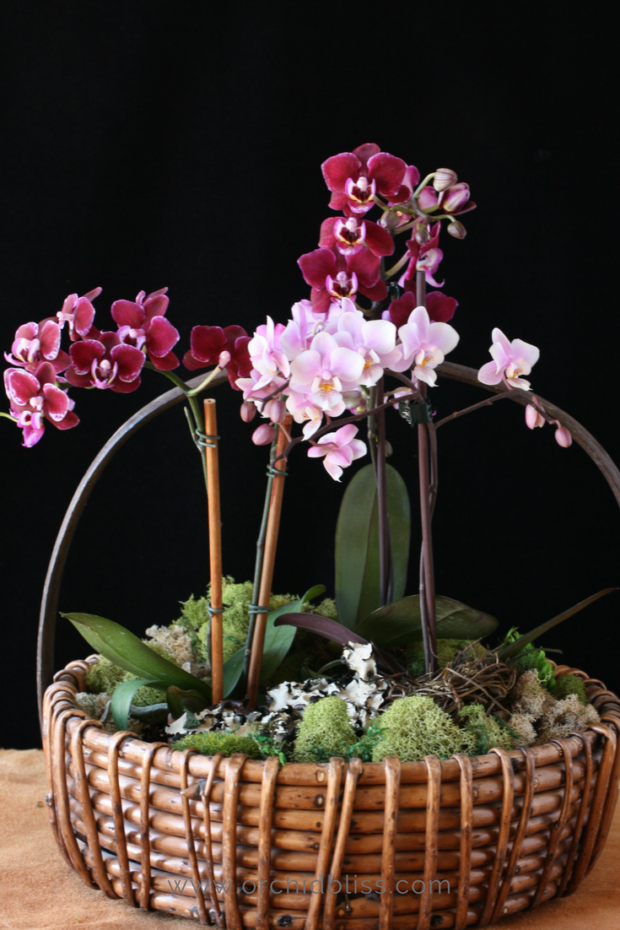
This display is much more convenient to care for than conventional, pre-made displays because the orchid pots are easily removable, making it super easy to water the plants. Also, this way if one of the plants finished flowering, it’s a simple job to replace it with another orchid. In addition to beautifying our own home, this arrangement is a lovely, thoughtful gift for any occasion.
With their crown of flowers, mini orchids are little princesses adorning our homes with grace and tranquility. Who would know that they are so easy to care for (and so inexpensive)?
Mini Phalaenopsis orchids make a perfect gift either for yourself or for someone else. Don’t underestimate a mini Phalaenopsis. They may be small, but they are tough.
A Big Noise About Mini Phals
The Phalaenopsis is one of my latest delights.

Hi Anna, I love my orchids and am enjoying their beauty and perfume now as they present with an array of colour and design. It is winter here in Australia and they brighten any dreary day.
The Phalaenopsis is one of my latest delights. It currently has 6 flowers and it is happily growing on my kitchen window sill. It likes the temperature that we humans enjoy. It is watered every 7-10 days. A great help I have found as to know how often to water is to put a wooden skewer in the pot. If the tip of the skewer is moist it is not ready for another drink yet.
Thanks for your regular tips on growing and getting orchids to flower.
I love moth orchids!

I’ve just taken in my third moth orchid and I love them! So simple and beautiful! One has a shoot and will probably flower at the beginning of the year, the other is still growing it's leaves and will probably send out a shoot soon! The third I just picked up today and has blooms!
I grow Phalaenopsis orchids.

I grow Phalaenopsis orchids. I have 5 and have been successful in getting them to re-bloom.
Beautiful Phalaenopsis

I have a beautiful Phalaenipsis Orchid, which was given to me in full bloom, as a gift in June of 2016. When the flowers dropped, I repotted it, and in September of 2017, a new spike began to grow. I am very happy to say, that I have been enjoying the flowers from this spike since late December of 2017, and still going! I have strong healthy leaves, and a great root system. I use AAA New Zealand Sphagnum Moss from rePot me web store, and have it placed in an East facing window. I have a humidity of around 55-58%, and generally have the room at about 73-76 degrees, depending on how sunny the day is. I find that I have to water the plants about 2-3x a week.





